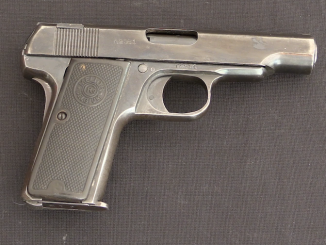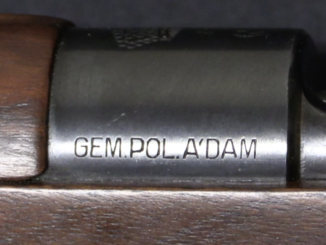Manufactured in the 1880s and 1890s to serve the professional hunter market, Pieper’s 7-barrel Mitrailleuse was essentially a rimfire volley gun. It was offer in both .22 rimfire and .32 rimfire calibers, both models having clusters of 7 rifled barrels which fired simultaneously with a single trigger pull. The purpose was to offer an alternative to the large-bore punt gun for effective hunting of fowl at extended range. A volley from one of these was essentially like firing a round of buckshot, but with each pellet actually a rifled bullet, thus providing much improved accuracy.
Sold for $4,600 (.22 caliber) and $7,475 (.32 caliber) at the December 2019 RIA Premier auction.




What’s the legal status in the US, they seem to fall under the multiple shots with a single trigger pull rule for NFA items?
I would surmise that in the US, this would be considered an antique not a regulated firearm. The .22 version may be in a grey area due to the easy availability of ammunition.
Good question, in that case, duplex and triplex ammo is by that definition also multiple projectiles with single trigger pull ?
Simultaneous discharge of multiple barrels by one trigger is not considered a cyclic action, so this actually does get around the whole “multiple rounds with one trigger pull” argument. It’s the same reason a Gatling gun is NOT legally a self-operating machine gun: The action must be manually actuated and the ammunition manually chambered, even if by hand-crank (so to speak).
Who knows really with the ATF? This volley pistol was just released earlier this year and they gave it a pass.https://www.thefirearmblog.com/blog/2019/01/04/standard-manufacturing-volleyfire/
Interesting design.
Now, I am waiting the demo at 100m range.
(Several years ago, I thought to a manual repeating 4 barrel design with box or tubular magazine holding packs of 4 cartridge starting with .22LR shootabable all at once, 2 by two or each at the time, but I realized soon at the era of mastered automatic hardware, it would be heavier and less powerful than a selective fire assault carbine. And the laws won’t be that permissive).
“packs of 4 cartridge starting with .22LR shootabable all at once”
French did something similar in concept but it used packs of 3 cartridge 5,56×45 NATO, see photo here: https://guns.fandom.com/wiki/MAT_Tritube
Once again, I re-invented the wheel 40 years later (or more depending on concepts/design)…
Thank you for sharing !
(The last design I have not heard about yet is a compact assault carbines with folding stock one or two additional barrel segment lodger where the cleaning rod used to be. The idea is to have it as a backup weapon (truck driver) or as paratrooper main infantry gun. When the situation cools down, the user can screw additional barrel segment to gain in accuracy and projectile velocity.
But after thinking twice, there might be bot reliability and accuracy problems.
*both
Ideas often appear independently in places distant in distance or time.
Forward Defense Munitions L5 might be seen as generally similar to Tritube, although using single cartridge but just with multiple bullets, which match respective barrels.
https://www.thetruthaboutguns.com/forward-defense-munitions-l5-caseless-ammo-5-bore-rifle/
“user can screw additional barrel segment to gain(…)projectile velocity.”
This sounds like Littlejohn adaptor: https://en.wikipedia.org/wiki/Littlejohn_adaptor
though it was not simply making “barrel” longer, but also squeeze projectiles (so called taper-bore) thus making it cross-section smaller and thus better retaining velocity vs distance. It did what it was supposed to do (and straight-bore gun + taper-bore extension was much simpler production-wise that German approach of using just taper-bore barrel, used in 2.8 cm sPzB 41 “heavy anti-tank rifle”), but it was counter-productive for firing HE, FRAG or similar shells, as HEAT shells (whose penetration is independent from strike velocity and could be throw by “normal” guns) become more and more effective, taper-bores faded into obscurity.
“(…) gain in(…)velocity. (…)”
Note that if you are able to get significant change then you need two sights to serve both “short” and “long” barrel.
Interesting Remington action. I wonder if a full bore rifle was ever built with an underlever Remington action and would it have been any quicker to operate than the double thumbing action.
https://www.invaluable.com/auction-lot/rare-remington-rolling-block-rifle-by-carlos-gove-59-c-388970cec9
In the 1890s, Denver CO gunsmith Carlos Gove made both underlever and sidelever rolling block target and long-range hunting rifle conversions. Generally, the single-set trigger actions had underlevers, while the double-set trigger ones had a side lever on the right. Typical calibers were .40-50 1 7/8″ Sharps Straight for target rifles or 50-90 Sharps for big game rifles.
cheers
eon
Lovely looking piece never knew it existed. Did anyone make a new underlever or just the Gove conversions.
The piece seems a “Falling Block” rather than Remington’s “Rolling Block”.
Both Pieper and Nagant brothers in Belgium made underlever rolling block actions in a whole range of calibers. Even side by side shotguns.
By the way, the lever also cocks the hammer.
They seem too nicely finished to be working guns. After all, to a market hunter they are just a tool(look at the typical punt gun – it may be well made but cetainly not embellished with beautiful high varnished furniture and egraving). So who was the real market? Or did Peiper make a misteak in the level of finish (eg cost) on these weapons for the intended demographic?
I also wonder about the concept. They’re big heavy guns, with a specialized role. Did Peiper expect you to carry two weapons, a shotgun for short range work, and one of these for long range? That’s a heavy and awkward load, not easy or quick to bring into action. So two partners working together (cuts into the profits!) or do you have a gun bearers carrying one of each for you (which puts it out of the working class market hunter demographic and much more in the Lord of the Manor and his ghillies)?
One of the very few videos I have to disagree with Ian..a professional waterfowl hunter who hunted for profit would never use such a gun, because the cost of spending seven metallic rifle cartridges Vs one single shot shell be uneconomical, and the improved power of the many rifle bullets would result in destruction of meat.
A punt gun was used for shooting whole swarms of birds at once, something this gun cannot do. Somehow these volley rifkes makes me think of a rich man’s deer gun, to be used in driven hunts when the game was running..
The .22RF was more likely an “upland game” gun, intended for grouse or quail. Ghillies would flush the birds, which would likely blast off in any direction except directly at the hunters. So quartering shots at ranges of 100 yards or so would be the norm.
English hunters tended to like larger shot such as No. 3 in their “twelve bore” doubles for such shooting, but even No. 3 tends to fall off in velocity and accuracy beyond 50-60 yards.
https://www.hunter-ed.com/images/pdfs/ammo_shot_sizes.pdf
So the .22 RF, which would be midway in size between T and No. 4 buck, would be a reasonable alternative, assuming the shooter led the target correctly.
I do acknowledge that I really can’t fathom what the .32 RF would be for. It’s shooting the equivalent of No. 1 buckshot, but with slightly better aerodynamics.
One possibility; No. 1 used to be called “boar shot” in Germany and France, because it was the minimum size recommended for shooting wild pig. Seven .32 RF slugs could be defined as the equivalent of one Porky’s worth of buckshot. So the .32RF may have been intended for boar-hunting on horseback.
cheers
eon
I agree. You are on target with that assumption l
Many years ago, American Rifleman magazine ran a short article about a 7-barrel .22 version of one of these weapons. They identified as a “goose gun,” without much explanation. (They needed Ian on their team; too bad he wouldn’t be born for another 25 years.) I was left with the impression that it was for bagging high-flying birds, big ones like geese or swans that would repay the expense of a specialized gun. Of course, as Ian points out, the sporting types of yesteryear made no bones about shooting sitting birds, and if long ranges were involved, here was the answer. Also, perhaps, the intent was to avoid startling a sitting flock by firing from longer distances. Buffalo hunters did it, so why not M. le Conte and his battue?
The utility I see with this concept is that you could load one round for small game, or up to seven for larger game or birds. Kind of a sideways approach to a combination gun or drilling.
It has always been my impression that these small-caliber volley guns were intended for a very specific niche as a higher-precision version of a “bank-gun” and used like bank- and punt-guns for flock-shooting sitting waterfowl at longer range, not for wing-shooting or for small game.
I can’t post pictures here, but the Pieper and Manufrance catalogues said that these guns- sans rivales dans le monde entier- were ABSOLUTEMENT PARFAIT and une Arme IDEALE pour les chasses si interessantes des canards, des corbeaux, et des oiseaux de proie.
The idea that they are for roebuck or boar in driven shooting makes theoretical sense, but they have always liked lots of power and high rates of fire for those shots, which are generally close range in the forests. It’s interesting in modern times to see a line of 7mm and .300 Winchester Magnum Browning Automatics and pumps deployed for 75 pound roe deer.
I’m betting less of a waterfowl gun, and more like a longer range buckshot effect, for deer or other animals. The .22 and .32 projectile is large for birds, isn’t it?
I should have said, that’s my opinion of a good use, despite the fact that the makers felt it was great for gees and such…